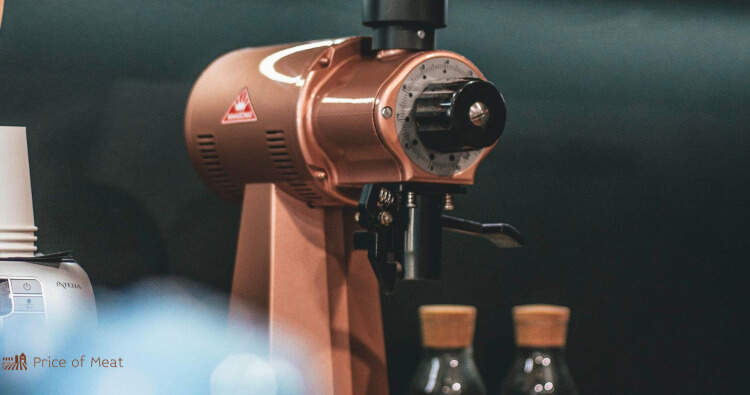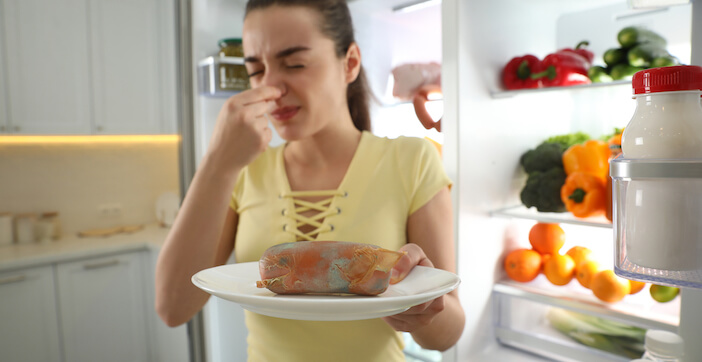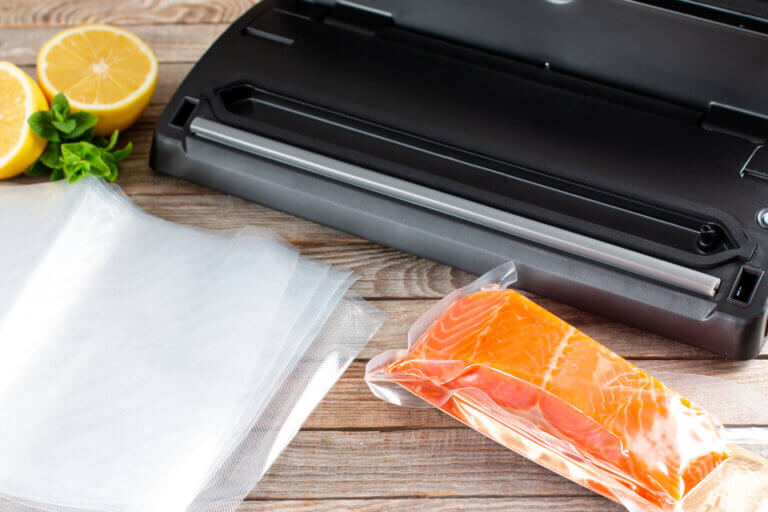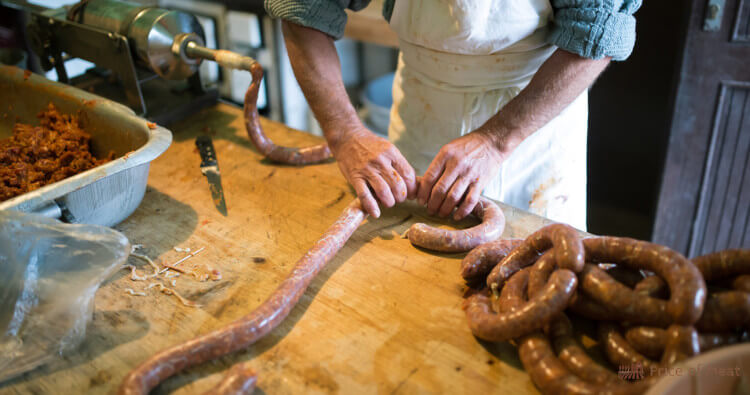5 Best Meat Vacuum Sealers: Tips & Buying Guide 2023
Choosing the best meat vacuum sealer involves considering quantity, budget, and type. We compared options to provide a complete guide for meat preservation.
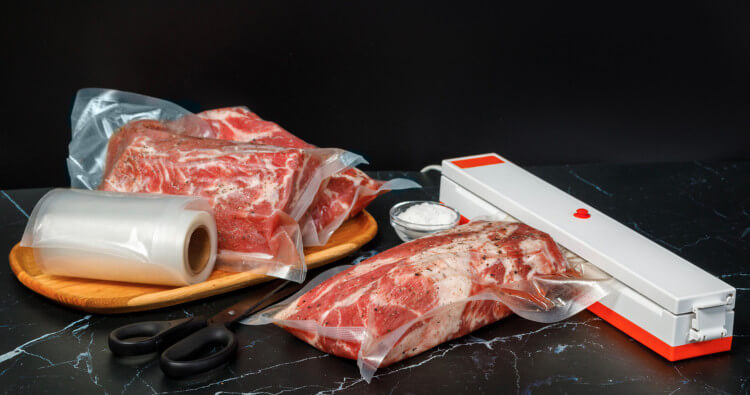
The popularization of cheap, simple, and effective vacuum sealers for home use has been a huge boon for preserving, storing, and preparing food in the comfort of your kitchen. But as with any kitchen gadget, there are plenty of imitators on the market that can’t deliver the results you’re looking for. How can you know that you’re getting the best vacuum sealer for meat?
We’ll take care of that for you. To make this guide, we compared our personal and professional experience using vacuum sealers with reviews and specifications of the most popular sealers available today — and ended up with what we hope is a complete guide to finding the best vacuum sealer to use for meat.
Follow along as we explain what exactly a vacuum sealer is (and how it works), as well as the different types of vacuum sealers you’ll be choosing amongst, considerations to take into account before buying, and our recommendations on two vacuum sealers for meat that really get the job done.
Disclosure: As an Amazon Associate, this site earns from qualifying purchases. Thank you!
What Is A Vacuum Sealer for Meat?
What’s the number one cause of spoilage? Oxygen, of course.
Vacuum sealers work on the principle of removing oxygen from the environment around food and thereby extending its shelf life. The technology was originally developed for use in professional kitchens, and has since been modified to create small and affordable vacuum sealers for home kitchens.
At its most basic, a vacuum sealer includes three things: A fan for removing air, a heat strip for sealing the plastic bags used for storage, and a control panel to streamline operation. Combined with appropriately sized vacuum sealer bags, this is all you’ll need to create an airtight seal around cuts of meat, perfect for freezing to extend their shelf life.
Vacuum sealers have achieved their greatest popularity for usage with meat through the work of French chefs. Using a technique known as sous vide (without air), they have achieved culinary feats that would have otherwise been impossible. As a cooking method, it was invented by Dr. Bruno Goussault in 1971 as he was search for a way to make the most tender roast beef in the world. Here’s what he has to say about cooking sous vide:
The power of sous vide is that it enables you to precisely prepare food with more tenderness and flavor than can be obtained through traditional cooking techniques. Sous vide makes it possible to unlock the full potential of food.
Types of Vacuum Sealers for Meat
There are two main types of vacuum sealers available on the market today: Countertop and chamber. Let’s take a closer look at each of them in turn:
Countertop vacuum sealers are the most commonly available type of sealer for home kitchens. Often weighing not more than a few pounds, and rarely exceeding two feet in length, they’re a compact and convenient choice for vacuum sealing small portions of food. Quality of fans and sealing strips can vary, however, making them a less reliable choice. They are significantly cheaper than chamber sealers, and much easier to buy in stores.
Chamber vacuum sealers are the gold standard for food preparation, and a necessity in today’s high class kitchens. By holding the product to be sealed in a pressurized chamber, they achieve a much tighter seal than countertop vacuum sealers. They’re large and expensive, but create a seal that is guaranteed to preserve your foods’ freshness for as long as possible.
Before You Buy: Considerations for Choosing A Vacuum Sealer for Meat
Choosing the best vacuum sealer for your needs comes down to three main considerations:
What Quantity of Meat Will You Be Sealing?
Are you looking to seal the occasional bulk quantity of meat to stow away in the freezer, or planning on using your vacuum sealer for commercial purposes? Or maybe somewhere in between, where you’ll have large quantities of meat to seal and store come hunting season? For smaller meat sealing projects, a countertop sealer will do the trick; larger or more commercial quantities of sealing will require the safety, reliability, and efficiency of a chamber sealer.
What Is Your Kitchen Equipment Budget?
The difference in price between countertop and chamber sealers is quite striking, with the former being readily available under $100 and the latter starting at $400. Be sure that your budget matches the project that you have in mind, because even the best countertop sealer won’t be able to keep up with a large volume or frequent use in the same way a chamber sealer can.
Which Type of Sealer Should You Get?
With those things in mind, which type of sealer is best for you? If you need a chamber sealer, the choice is quite easy as there are many fewer models on the market. Countertop sealers, on the other hand, have become the latest hot kitchen gadget — so if you’re looking to add one to your kitchen, beware the many low-quality imitators available online.
Common Mistakes
One of the most common (and avoidable) mistakes people make when attempting to vacuum seal meat is using bags that are too large.
The basic principle of sealing food in plastic is that it must be done rapidly, before the air inside the bag has a chance to warm up and expand. If you put a frozen meat product in a bag that is too large, the air inside will expand as it warms up, pushing the product away from the sealing strip. You’ll know you’ve done this because there will be a gap between your food and the sealer after you attempt to vacuum out the air.
To avoid this problem, only ever use bags that are specifically made for vacuum sealing food. They are sized to be roughly 1/4 of the volume inside them, ensuring that there’s no room for expansion.
Some people also make the mistake of not tightening their sealing strip before starting out. You can tell if your machine has this problem by turning it on without a bag in place – if the line runs along the base of the machine, your strip isn’t tight enough. A loose seal will result in leaks when you start vacuum sealing food – not exactly what you want with something as perishable as meat!
Always double check that your sealer has a tightly-fitted sealing strip before starting out. If it is too loose, tighten the screws until it is snug, but do not over-tighten them or you risk stripping the plastic.
Frequently Asked Questions
Here are a few common questions about vacuum sealers for meat.
What foods can you vacuum seal?
You can seal almost anything with a vacuum sealer including coffee, cereal, pet foods, liquids (such as soup), delicate clothing like silks and crochets. No matter what food you are sealing – vacuum sealing ensures better tasting food that keeps its natural flavor longer.
How long does vacuum sealed meat last in the freezer?
A vacuum-sealed meat will last for over 5 years in the freezer. Most can be kept indefinitely (at least 8-10 years).
How does a vacuum sealer work?
The physical process of sealing food in plastic is that it must be done rapidly, before the air inside the bag has a chance to warm up and expand. If you put a frozen meat product in a bag that is too large, the air inside will expand as it warms up, pushing the product away from the sealer and causing a gap between your food and the sealer. Vacuum sealing prevents this because when you vacuum-seal foods in smaller bags, there isn’t any room for expansion–and your meat won’t get pushed away from your machine when all of its air gets sucked out!
A countertop cleaner typically comes with an accessory hose that attaches to one’s home’s faucet or onto portable tap. Soak surfaces clean with either hot or cold water. Use this to spray down surfaces of the sealed bag before opening (because of meat juices) and for cleaning up spills immediately after they happen–this is very important because keeping your surfaces clean will ensure that there are no bacteria buildups near your food!
What are the benefits of a vacuum sealer?
There are plenty of benefits to using a vacuum sealer! A good vacuum sealer helps preserve the food you’re sealing by allowing you to remove all the air, which can cause spoilage. Vacuum sealing also gives you more control over how much air is removed from your food–because not all foods need the same amount of air removed! Foods that are tough or stringy might be sealed on a lower setting while more delicate or moist items might need higher settings to get the right level of quality.
The best benefit of owning a vacuum cleaner is that it’s great for storing meals–you can make something in advance, put it into large bag and suck out most (or all) of the air out. This way when it’s time to eat, you can take one item out of the freezer and stick it straight into the cooker or oven, saving yourself a lot of time.
Vacuum sealers are also great for marinating meats–the flavors will be pushed deep inside the meat, ensuring that every bite is packed with delicious flavor! What’s more – a vacuum sealer is also able to keep your food moist, providing you with juicy meats that are always tender.
Why invest in a vacuum sealer?
The benefits of a vacuum sealer are sure to change the way you store and reheat your food. These machines save a lot of space in the freezer–making room for more treats! You’ll also find that cooking with a vacuum sealer is fast, easy and healthier than using canned foods because you’re using fresh ingredients from scratch.
Where to buy a Vacuum Sealer for Meat
Now that you know which type of sealer is right for your kitchen, lets take a look at a great example of both styles:
The Countertop Vacuum Sealer
Mueller Austria’s countertop vacuum sealer gives you everything you want from a home use sealer, and is available for a remarkably affordable price. It’s exceptionally easy to use, and has the best longevity of any countertop sealer we’ve seen for under $100. Highly recommended for the home kitchen, though it would struggle to keep up with a large volume of meat packing.
- ❇️ SAVE MONEY AND TIME: Cooking and meal preparation is now easier, more economical and faster, as you will be able to equip and organize your freezer, with fresh food ready to be defrosted and served or fresh ingredients instead of freezer burned food filled with ice crystals which will probably end up in the trash can.
- ❇️ COULDN’T BE EASIER: Fully automatic simple electric plug in design with the control center placed on the top panel and soft touch digital buttons along with led indicator lights. A smart device at your family’s service!
- ❇️ DUAL SEALING MODES: Useful and practical, the MUELLER vacuum sealing system is cleverly designed HAVING two selectable modes to provide your food with the best possible preservation based on the type of food you want to seal. You can choose the dry setting for solid food items and the moist setting for poached, simmered or steamed food.
- ❇️ TRUSTED MUELLER QUALITY LAB TESTED: Vacuum sealers preserve food up to 5 times longer than zipper baggies or containers, basically depending on the type of food. The Mueller Vacuum Sealer however, was subjected to harsh laboratory testing to effectively increase food shelf life and keep doing so for years to come.
- ❇️ EVERYTHING YOU NEED RIGHT OUT OF THE BOX: Along with the vacuum sealer and the air suction hose, the Mueller vacuum sealer package also includes: 5 medium vacuum bags (7.8” x 11.8”) and one extra-long vacuum bag roll (7.8” x 79.0”), both kinds being reusable and waterproof. A complete bundle right out of the box.
The Chamber Vacuum Sealer
VacMaster is the go-to vacuum sealer for the restaurant industry, and for good reason: They’re nearly indestructible, incredibly efficient, and can handle large volumes of sealing without losing any quality. The VacMaster VP215 Chamber Vacuum Sealer is their flagship model, and though it’s quite pricey compared to a countertop sealer, it’s actually the most reasonably priced of chamber sealers. If you’re going to be sealing large cuts of meat, it’s an absolute must.
- Easy To Use Control Panel and Pressure Indicator - Perfect vacuum and seal with minimal effort with one-touch controls. For a quick seal simply hit the stop button to seal the bag and the chamber will open.
- Quality At Home and Reliable for Your Business - With the compact design this vacuum sealer is the perfect crossover for home and commercial use. Stands up to prolonged and continuous use that delivers a strong vacuum and seal every time. The small footprint makes it convenient for storage, transporting and will save countertop space while still maximizing your sealing capacity with a 10.25” chamber vacuum seal bar to accommodate a 10”x13” bag for someone sealing large portions or food items.
- Leak-Proof - VacMaster VP215 provides a double seal for an extra layer of protection to extend food shelf life and ensure freshness.
- Improved Flavors by Marinating Foods & Infusing Cocktails - VP215 can vacuum package a variety of liquids and liquid rich food like soups, sauces, and marinades.
- VacMaster VP215 Specifications - Overall Dimensions (WxDxH): 14” x 20” x 15” | Chamber Size (WxDxH): 11.25” x 15.25” x 5” | Seal Bar Size 10.25” | Maximum Bag Size 10” x 13 | Pump: Heavy-Duty 1/5 HP Oil Pump |Weight: 84 lbs.
Thanks for taking the time to read, and best of luck with your next vacuum sealing project!



